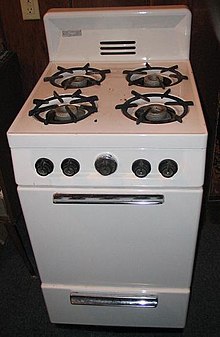User:HunterGoss1/Fire safety
Common fire hazards
[edit]
Some common fire hazards are:[1]
- Kitchen fires from unattended cooking, grease fires/chip pan fires
- Electrical systems that are overloaded, poorly maintained or defective
- Combustible storage areas with insufficient protection
- Combustibles near equipment that generates heat, flame, or sparks
- Candles and other open flames
- Smoking (Cigarettes, cigars, pipes, lighters, etc.)
- Equipment that generates heat and utilizes combustible materials
- Flammable liquids and aerosols
- Flammable solvents (and rags soaked with solvent) placed in enclosed trash cans
- Fireplace chimneys not properly or regularly cleaned
- Cooking appliances - stoves, ovens
- Heating appliances - fireplaces, wood-burning stoves, furnaces, boilers, portable heaters, solid fuels
- Household appliances - clothes dryers, curling irons, hair dryers, refrigerators, freezers, boilers
- Chimneys that concentrate creosote
- Electrical wiring in poor condition
- Leaking/ defective batteries
- Personal ignition sources - matches, lighters
- Exterior cooking equipment - barbecue
- Electronic and electrical equipment - Lithium-ion battery's have recently became very popular in the fire safety world. Lithium ion batteries are used for a variety of devices like Tesla, Inc., Scooter-sharing system and many more. When in normal usage, these batteries work properly and safely, But once the battery has become damaged either through a wreck or wear and tear, an exothermic reaction from Thermal runaway causes a release of heat and fire. This process extends and ignites to combustible materials in close proximity. These batteries used in electric scooters are often seen in city settings and stored in residential homes/apartments. The batteries are difficult to extinguish, requiring copious amounts of water. Once the fire has been put out the battery is still considered flammable for 7-14 days. Wrecked electric vehicles can reignite in the scrap yard days after they were originally set fire and extinguished.
Fire Extinguishers: A Fire extinguisher is used heavily across the globe. These are used to control small, incipient stage fires in a home or workplace. Extinguishers are used by an acronym called PASS. P - Pull, pull the safety pin located on top beside the handle, A - Aim, aim the nozzle of the extinguisher at the base of the fire. S - Squeeze, squeeze the handle to discharge the extinguisher. S - Sweep, sweep the nozzle across in a lateral motion from left to right on the base of the fire. Fire extinguishers should be used from a distance of 3-7 feet from the fire, based on the manufactures guidelines.
Public fire safety education[edit]
[edit]Most U.S. fire departments have fire safety education programs.
Fire prevention programs may include distribution of smoke detectors, visiting schools to review key topics with the students and implementing nationally recognized programs such as NFPAS "Risk Watch" and "Learn not to burn".
Other programs or props can be purchased by fire departments or community organizations. These are usually entertaining and designed to capture children's attention and relay important messages. Props include those that are mostly auditory, such as puppets and robots. The prop is visually stimulating but the safety message is only transmitted orally. Other props are more elaborate, access more senses and increase the learning factor. They mix audio messages and visual cues with hands-on interaction. Examples of these include mobile trailer safety houses and tabletop hazard house simulators. Some fire prevention software is also being developed to identify hazards in a home.
Fire departments help share the message of changing the batteries on the Smoke detector's inside the home. Experts advise that the user change the battery every 6 months. Often advising to change the batteries when you change the change your clock for spring forward and fall back (Daylight savings time).
All programs tend to mix messages of general injury prevention, safety, fire prevention, and escape in case of fire. In most cases the fire department representative is regarded as the expert and is expected to present information in a manner that is appropriate for each age group.
References:
remove the following references # 1, 8, 10, 11, 18
14. https://www.researchgate.net/publication/328075851_Fire_Safety_in_Buildings
15. https://www.usfa.fema.gov/downloads/pdf/publications/firefighter-fatalities-2002.pdf
Add following references
https://www.nfpa.org/education-and-research/home-fire-safety/lithium-ion-batteries
https://www.nyc.gov/assets/fdny/downloads/pdf/codes/dangers-of-lithium-ion-batteries.pdf
| This is the sandbox page where you will draft your initial Wikipedia contribution.
If you're starting a new article, you can develop it here until it's ready to go live. If you're working on improvements to an existing article, copy only one section at a time of the article to this sandbox to work on, and be sure to use an edit summary linking to the article you copied from. Do not copy over the entire article. You can find additional instructions here. Remember to save your work regularly using the "Publish page" button. (It just means 'save'; it will still be in the sandbox.) You can add bold formatting to your additions to differentiate them from existing content. |
Article Draft
[edit]Lead
[edit]Article body
[edit]References
[edit]- ^ "Fire Safety". Fire Protection Specialists. Archived from the original on 19 January 2014. Retrieved 17 January 2014.
